|
Peace be with you! Perhaps you are
not Catholic and are visiting this website. We’d like to welcome you
and show you our parish church.
By the doors of every Catholic
Church there are small bowls of water – sometimes attached to the wall
or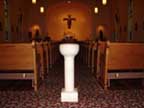 otherwise freestanding. We call
this “Holy Water.” It is not magical and we have no superstitions about
it. We place it upon ourselves with the “Sign of the Cross,” all the
while remembering that we are baptized persons. The Christian meets
Christ for the first time in the water of Baptism. It is there that we
are “born again,” “born from above.” Baptism
is our “second birth” whereby we begin the long process of assuming the
likeness of Christ in faith and love. otherwise freestanding. We call
this “Holy Water.” It is not magical and we have no superstitions about
it. We place it upon ourselves with the “Sign of the Cross,” all the
while remembering that we are baptized persons. The Christian meets
Christ for the first time in the water of Baptism. It is there that we
are “born again,” “born from above.” Baptism
is our “second birth” whereby we begin the long process of assuming the
likeness of Christ in faith and love.
The focal point of our church is
the altar-table in the sanctuary. Catholics have been gathering for the
“Breaking of the Bread” for over 2000 years now. We call the event
“Mass” or the “Liturgy.” The word “Mass”
comes from the Latin word “missa” – dismissal. We don’t stay in church
at the end of the liturgy, but we are dismissed so to bring Christ to
the world.
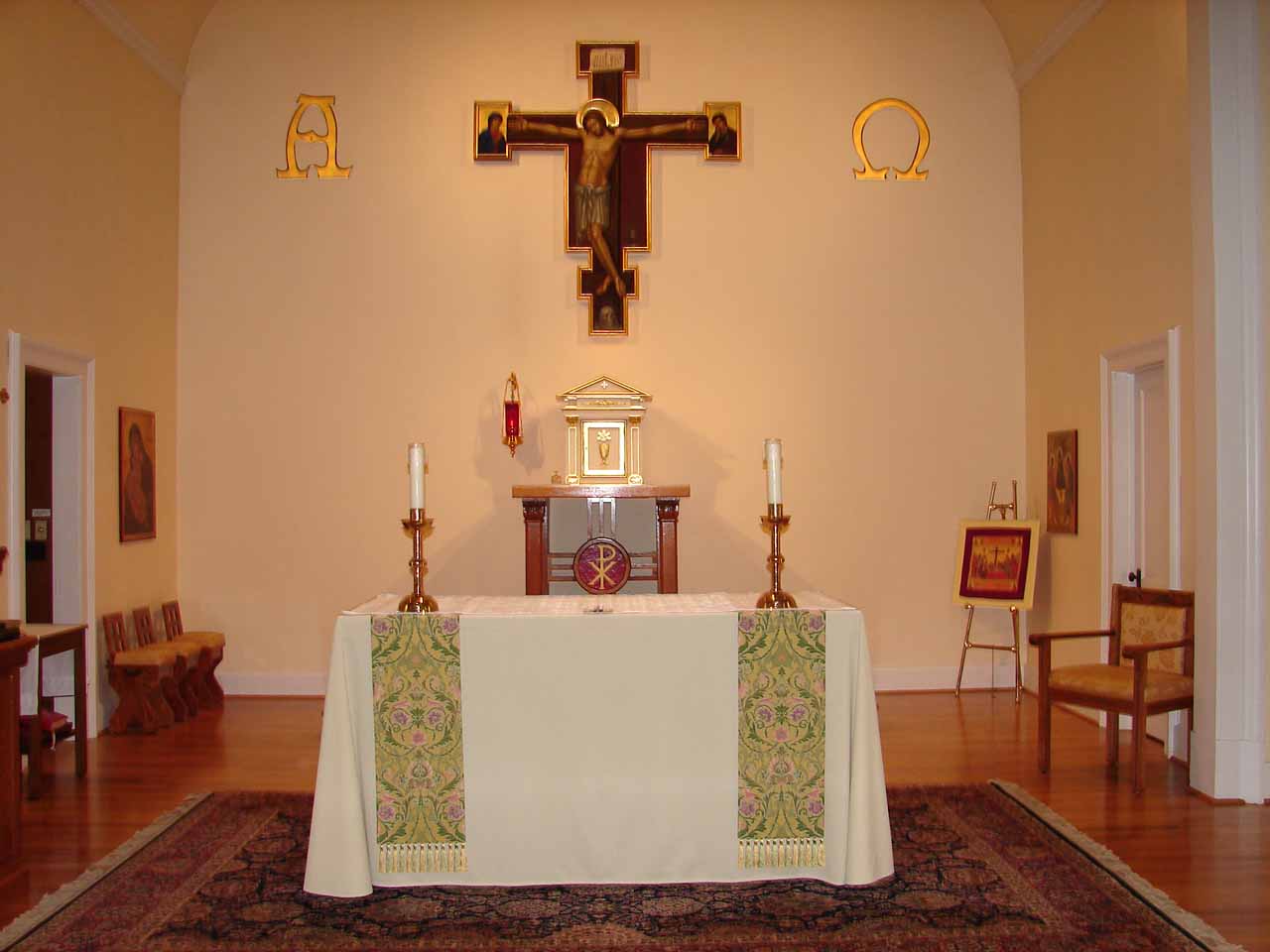
At Mass Jesus “re-presents” or
renews His Calvary gift. This is why the Sacred Food is broken, poured
out, emptied, given away. This images Jesus offering of Himself to the
Father always – interceding and pouring Himself out for our world. The
Letter to the Hebrews speaks of this priestly role of Jesus.
We believe that the Bread and the
Wine are changed into Christ’s Body and Blood. Why do we believe it?
Simply because He said it and He is the Truth. He will not lie to us.
We take Him at His word and we also know very deeply that in order to
live lives of love we need to be fed regularly. You can’t take a
journey without food.
At the top of the 3 stairs behind
the altar is a “tabernacle.” It is a kind of “Ark of the Covenant.”
Unlike a contract, a covenant is a heart to heart agreement. Christ’s
heart – our hearts – in prayer, in trust, in joyful confidence. Our
prayer is that of adoration, ever expanding and
deepening gratitude, contrition for
our own sins and the sins of the world, supplication
or intercession for a needy and troubled world.
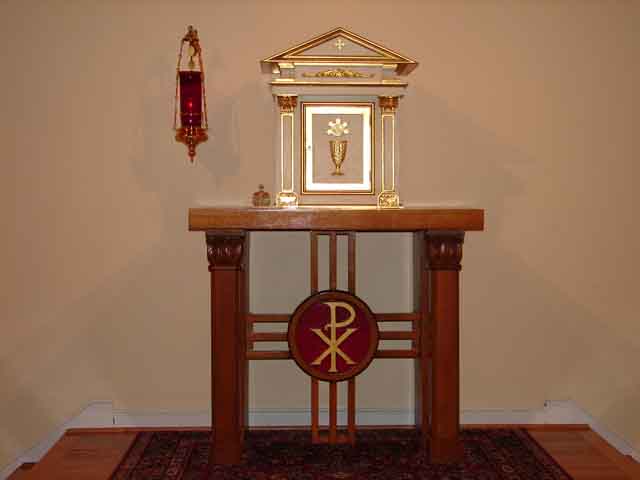
A red light burns by the
tabernacle. It is a light of presence. It is a kind of “Burning Bush”
or like the lamps in the ancient temple. God is here! The light “says.”
Christ is our light. And so wherever candles burn in church we remember
that at our baptism we were entrusted with a burning candle and told to
keep the flame of faith alive in our hearts and to walk by Christ’s
light until he returns for us. In the back of our Church there is a
lovely prayer for the lighting of a candle:
“Oh Christ our Savior
Shed Your light upon the path I
have to tread,
That I may keep it without
stumbling and without faltering,
And come in the end to see you face
to face
In the heavenly Kingdom. Amen.”
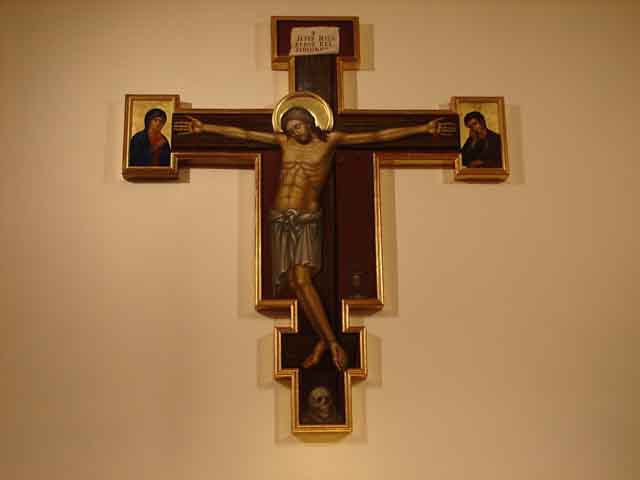 The Crucifix is above the sanctuary
wall. The body of Christ is on the cross which is exactly what makes
for a crucifix. Of course we know that Jesus is not on the cross any
longer. He is risen! But to see the image of Jesus on the cross says,
“Look at what human sin has done!” It also says in the gesture of
outstretched arms, “Here is love that seeks to embrace and encompass
all the shipwreck which is this world.” The Crucifix is above the sanctuary
wall. The body of Christ is on the cross which is exactly what makes
for a crucifix. Of course we know that Jesus is not on the cross any
longer. He is risen! But to see the image of Jesus on the cross says,
“Look at what human sin has done!” It also says in the gesture of
outstretched arms, “Here is love that seeks to embrace and encompass
all the shipwreck which is this world.”
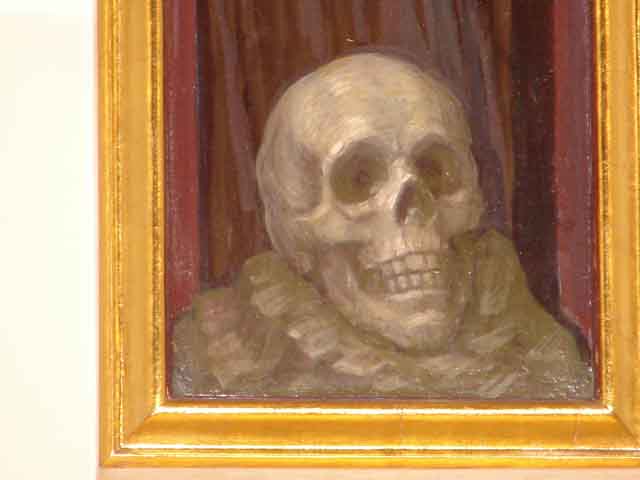 Why
is there a skull on the bottom of the cross? Jesus was crucified at
Golgotha. Golgotha means “skull place.” Translated
into Latin it is “Calvarium.” This is how we arrive at the word Mount
Calvary. But an ancient tradition says that the cross of Jesus was set up over the burial
place of Adam. The skull represents all of sinful humanity for which
Jesus died. Sometimes the Blood of Christ seems to wash over the skull
– as if to wash away our terrible pride and hunger for power. Why
is there a skull on the bottom of the cross? Jesus was crucified at
Golgotha. Golgotha means “skull place.” Translated
into Latin it is “Calvarium.” This is how we arrive at the word Mount
Calvary. But an ancient tradition says that the cross of Jesus was set up over the burial
place of Adam. The skull represents all of sinful humanity for which
Jesus died. Sometimes the Blood of Christ seems to wash over the skull
– as if to wash away our terrible pride and hunger for power.
|
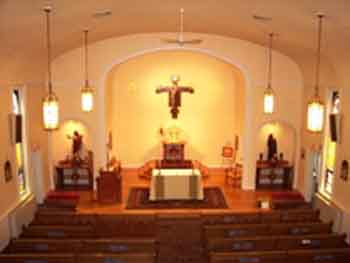 The
alpha and omega are seen on the wall as well on either side of the
crucifix. Jesus Christ is indeed the beginning and the end for us – the
beginning and end of every day, every work we undertake, every
relationship, and every project. The
alpha and omega are seen on the wall as well on either side of the
crucifix. Jesus Christ is indeed the beginning and the end for us – the
beginning and end of every day, every work we undertake, every
relationship, and every project.
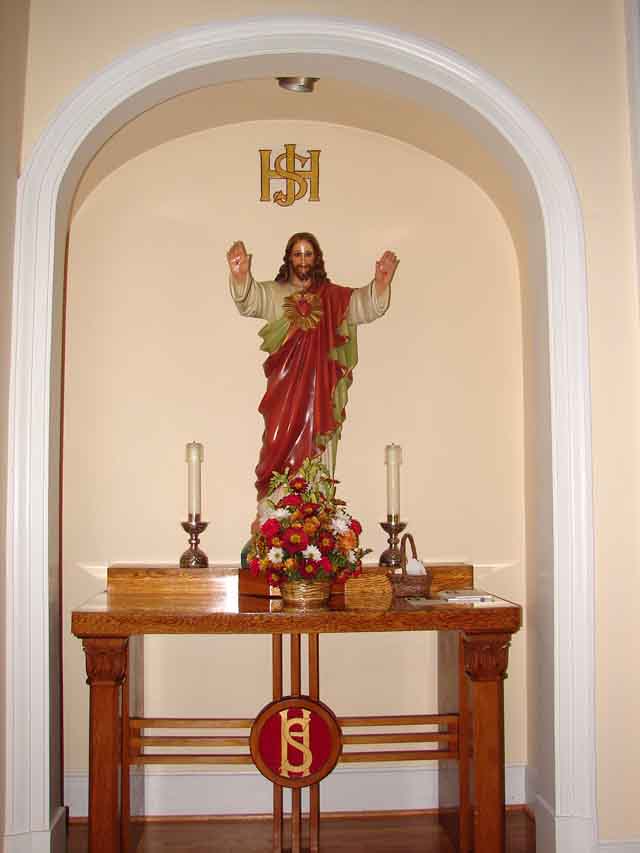
There are a couple of statues in
our church. We don’t worship them. They are not gods. But they are
places of pause and mindfulness. They are places that invite us to
consider and to pray. This statue is of the Sacred Heart of Jesus. In
the Heart of Jesus the world
meets and encounters the “heart” of God. This is the Incarnation –
Christmas. God becomes picturable in the Incarnation. God becomes
knowable through the sensory things of this world. The Church knows
this and employs it in our spiritual living. The Incarnation
legitimates the use of images, statues and paintings and other kinds of
artistic work. It makes for a bright, warm and rich spiritual
environment.
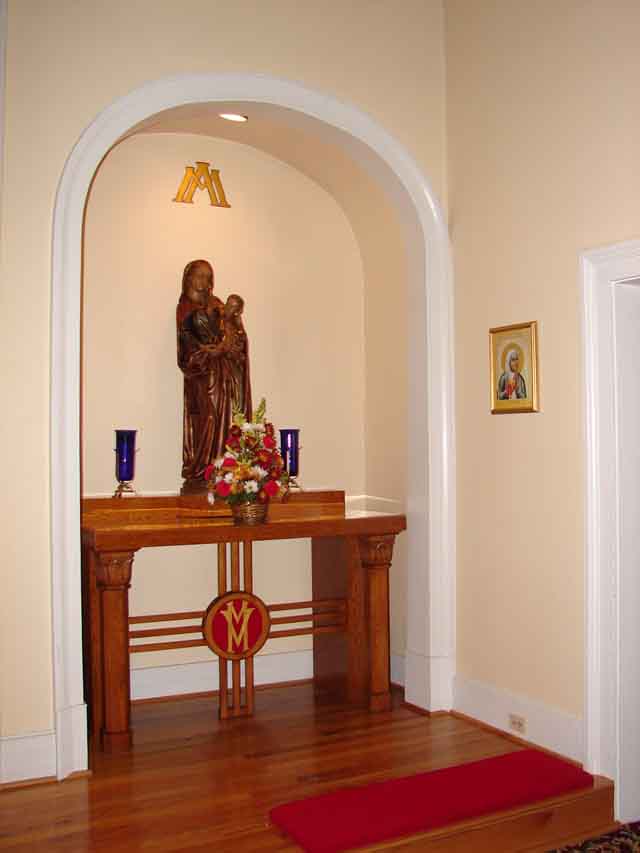 To
the right of the sanctuary is a statue of Mary – Jesus’ Mother. In 431
A.D. (long before the Reformation) the Church gave Mary the title,
“Theotokos,” which means “God-Bearer.” Actually
it is a title more about Jesus and his divinity than about Mary. She’s
important! She is in the gospel, “not for nothing,” as they say. She
images Christian discipleship for us. She is the first to welcome
Jesus, the first to say “Yes” to Jesus. Even before Peter! And She
says, “Yes” though it will cost her dearly – A “sword of sorrow will
pierce your heart,” old Simeon says in Luke’s Gospel. At the
Visitation, Elizabeth calls Mary, “Blessed among women.” We’re happy to
share Elizabeth’s greeting and belief. And Mary says of Herself in the
Magnificat, “Henceforth, all generations will call me blessed,” We
agree! To
the right of the sanctuary is a statue of Mary – Jesus’ Mother. In 431
A.D. (long before the Reformation) the Church gave Mary the title,
“Theotokos,” which means “God-Bearer.” Actually
it is a title more about Jesus and his divinity than about Mary. She’s
important! She is in the gospel, “not for nothing,” as they say. She
images Christian discipleship for us. She is the first to welcome
Jesus, the first to say “Yes” to Jesus. Even before Peter! And She
says, “Yes” though it will cost her dearly – A “sword of sorrow will
pierce your heart,” old Simeon says in Luke’s Gospel. At the
Visitation, Elizabeth calls Mary, “Blessed among women.” We’re happy to
share Elizabeth’s greeting and belief. And Mary says of Herself in the
Magnificat, “Henceforth, all generations will call me blessed,” We
agree!
Do we pray to Her? Yes. Why?
Because Jesus listened to His Mother. Good sons do that. And she is
alive in heaven, yes? In the Resurrection? We regularly ask people to
pray for this or that concern, why wouldn’t we ask the Mother of Jesus
to pray for us as well. Does she have power in Her prayer? Why not?
Especially if I believe there is power in my neighbor’s or relative’s
prayer!
Our statue of Mary shows Jesus
resting happily by Her, in Her arms. He is an image of each of us. Our
souls are held by God tenderly, maternally like this.
The “Stations of the Cross” are on
the walls of the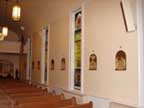 church. This is a wonderful prayer
because we walk along as we pray. There are 14 stops that tell the
story of our salvation in the passion and death of Jesus. He is
condemned, he falls repeatedly and gets up again (don’t we all?), He
meets His Mother (She must have suffered deeply with Him.) Simon helps
to carry the cross and Veronica wipes his face (images of the serving
Christian.) Jesus consoles the women of Jerusalem; He is stripped of
His clothes, is nailed to the cross, crucified and buried. Jesus
suffers still in the broken, the poor, the forsaken, the anguished, the
despised, the marginalized and those killed so unjustly. church. This is a wonderful prayer
because we walk along as we pray. There are 14 stops that tell the
story of our salvation in the passion and death of Jesus. He is
condemned, he falls repeatedly and gets up again (don’t we all?), He
meets His Mother (She must have suffered deeply with Him.) Simon helps
to carry the cross and Veronica wipes his face (images of the serving
Christian.) Jesus consoles the women of Jerusalem; He is stripped of
His clothes, is nailed to the cross, crucified and buried. Jesus
suffers still in the broken, the poor, the forsaken, the anguished, the
despised, the marginalized and those killed so unjustly.
We have a pulpit too. Catholics
hear a great deal of Sacred Scripture in our liturgical gatherings. At
weekday Masses there is always an Old Testament or New Testament
reading, followed by a Psalm and a Gospel.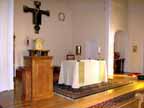 On Sundays
there are readings from the Old Testament and New Testament, a Psalm
and Gospel. Masses for other needs and occasions and feast days broaden
the exposure still further. We take the sermon or homily very
seriously. It seeks to open up God’s Word to us. We want to live the
Gospel-Life deeply. On Sundays
there are readings from the Old Testament and New Testament, a Psalm
and Gospel. Masses for other needs and occasions and feast days broaden
the exposure still further. We take the sermon or homily very
seriously. It seeks to open up God’s Word to us. We want to live the
Gospel-Life deeply.
|